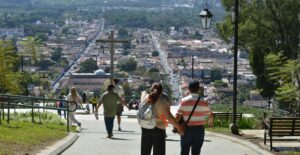
Fuego vs. Santiaguito Volcano Guatemala: Which One Has the Most Dramatic Eruptions?
Guatemala is home to some of the most active volcanoes in the world, with Volcán Fuego and Santiaguito volcano Guatemala standing out as two of the most spectacular. Both erupt frequently, offering incredible displays of volcanic power. However, their eruption styles, sizes, and viewing opportunities differ significantly. If you are looking for the most dramatic eruption experience, understanding these differences can help you decide which volcano to visit.
Eruption Style: Explosive vs. Dome-Building
The way a volcano erupts determines the kind of experience visitors can expect. Fuego and Santiaguito volcanoes in Guatemala have very different eruption styles, making each unique in its own way.
Fuego’s Explosive Eruptions:
Volcán Fuego is famous for its frequent and explosive eruptions. It spews lava, ash, and gas high into the sky, often accompanied by thunderous sounds and shock waves. This type of eruption, known as a Strombolian eruption, creates a mesmerizing and dramatic display, especially at night. Occasionally, Fuego experiences larger eruptions that produce pyroclastic flows, adding to its reputation as one of the most active and dangerous volcanoes in Central America.
Santiaguito’s Dome-Building Eruptions:
Santiaguito, on the other hand, is a lava dome complex formed after the massive eruption of Santa María Volcano in 1902. Its eruptions are less explosive but still powerful. Santiaguito regularly produces slow-moving lava flows, ash plumes, and occasional rockfalls. Unlike Fuego, its activity is more consistent but less visually dramatic from a distance. Instead of shooting lava into the sky, Santiaguito volcano Guatemala builds up its dome over time, leading to periodic collapses that can result in pyroclastic flows.
Size and Location: Towering vs. Compact
Size and geography also play a significant role in how these two volcanoes are experienced.
Fuego’s Dominance in the Landscape:
Standing at 3,763 meters (12,346 feet), Volcán Fuego is an imposing presence near Antigua. Its towering height makes it visible from miles away, and its eruptions can be seen even from Guatemala City on clear nights. The elevation and accessibility of nearby Acatenango make Fuego one of the best volcanoes for witnessing eruptions up close.
Santiaguito’s Compact Power:
Santiaguito, by contrast, sits at the base of Santa María Volcano and reaches about 2,500 meters (8,202 feet). While it may not be as tall, its eruptions still pack a punch. Its location in a more remote part of Guatemala makes it less visited compared to Fuego, but for those who make the journey, it offers a unique perspective on volcanic activity.
Viewing Opportunities: Nighttime Fireworks vs. Daytime Activity
Seeing an active volcano is a thrilling experience, but the way each volcano can be observed is quite different.
Best Ways to See Fuego:
The most popular way to witness Fuego’s eruptions is by hiking Acatenango, its neighboring volcano. From the Acatenango base camp, visitors can watch lava bursts and ash clouds light up the night sky. Guided hikes provide an unforgettable overnight camping experience, allowing travelers to marvel at Fuego’s activity up close.
For those who prefer not to hike, Fuego’s eruptions can still be seen from various vantage points. The colonial city of Antigua offers stunning distant views, while certain viewpoints along the Pan-American Highway provide a glimpse of its fiery displays.
If you’re ready to see Fuego by hiking Acatenango, reach out to Tropicana. We offer guided tour packages that take you to the best vantage points for an unforgettable experience. We also provide comfortable accommodations in Antigua, so you can rest before or after your hike. Contact us anytime, and let us help you plan your adventure.
Best Ways to See Santiaguito:
Santiaguito’s activity is best observed during the day. One of the top vantage points is from the summit of Santa María, which provides a breathtaking bird’s-eye view of the lava dome. Hikers can see ash plumes rising from the crater and, with some luck, minor eruptions or rock collapses. Because Santiaguito does not produce large lava explosions like Fuego, it does not offer the same nighttime spectacle, but it provides an up-close view of ongoing dome growth and volcanic changes.
Accessibility and Hiking Difficulty
Hiking difficulty plays a crucial role in deciding which volcano to visit. While both volcanoes are active, they require different levels of effort to experience up close.
Hiking Acatenango for Fuego’s Eruptions:
Hiking Acatenango is a must for the most breathtaking view of Fuego’s eruptions. This challenging trek takes about 5–6 hours and demands endurance as well as acclimatization to high altitudes. The reward? An unforgettable sight of Fuego’s fiery displays, especially at night, when glowing lava illuminates the sky.
For the more adventurous, an optional side trek to Fuego’s saddle offers an even closer look at its eruptions. However, this route is more dangerous due to the risk of pyroclastic flows, so caution is essential.
If you’re ready to take on the Acatenango hike, Tropicana is here to help! We offer guided tours and expert planning to make your adventure seamless. Contact us anytime, and let’s plan your unforgettable trek.
Climbing Santa María for Santiaguito’s Activity:
Observing Santiaguito’s eruptions requires hiking up Santa María, which is also a strenuous climb. The hike takes around 4–6 hours, and the summit offers a panoramic view of Santiaguito’s dome. Unlike Fuego, where you can watch lava eruptions from a nearby peak, Santiaguito’s eruptions are less predictable, and activity levels vary.
Which Volcano Offers the Most Dramatic Eruptions?
If you are looking for the most visually stunning and dramatic eruptions, Volcán Fuego is the clear winner. Its Strombolian eruptions, lava flows, and frequent activity make it one of the best places in the world to witness volcanic fireworks. The contrast of glowing lava against the dark sky creates an unforgettable sight, especially when viewed from Acatenango.
However, if you are more interested in geological processes and long-term volcanic activity, the Santiaguito volcano Guatemala offers a fascinating experience. Watching a lava dome grow, collapse, and rebuild itself over time provides a different but equally interesting look at volcanic power. While not as explosive as Fuego, Santiaguito still presents moments of intense activity that showcase the dynamic nature of Guatemala’s volcanoes.
Safety Considerations for Visiting Active Volcanoes
Regardless of which volcano you choose to visit, safety is a top priority. Here are a few precautions to keep in mind:
- Always hike with a certified guide, especially when visiting active volcanic areas.
- Check weather conditions and eruption activity before planning your trip.
- Bring proper gear, including hiking boots, warm clothing, and a headlamp for overnight hikes.
- Be aware of potential hazards like falling ash, sudden eruptions, and altitude sickness.
- Follow local advisories and respect restricted zones to avoid dangerous areas.
Final Thoughts
Both Fuego and Santiaguito offer incredible volcanic experiences, but they cater to different types of adventurers. If you want to see fiery explosions lighting up the sky, Fuego is the better choice. If you prefer a quieter yet equally impressive display of volcanic forces at work, Santiaguito volcano Guatemala will not disappoint. No matter which volcano you choose to visit, Guatemala’s volcanic landscape promises an unforgettable adventure.
For those seeking the ultimate volcanic experience, consider visiting both. Each offers a unique perspective on the power of nature, making Guatemala a dream destination for volcano enthusiasts and adventure seekers alike.



 Previous Post
Previous Post Next Post
Next Post



